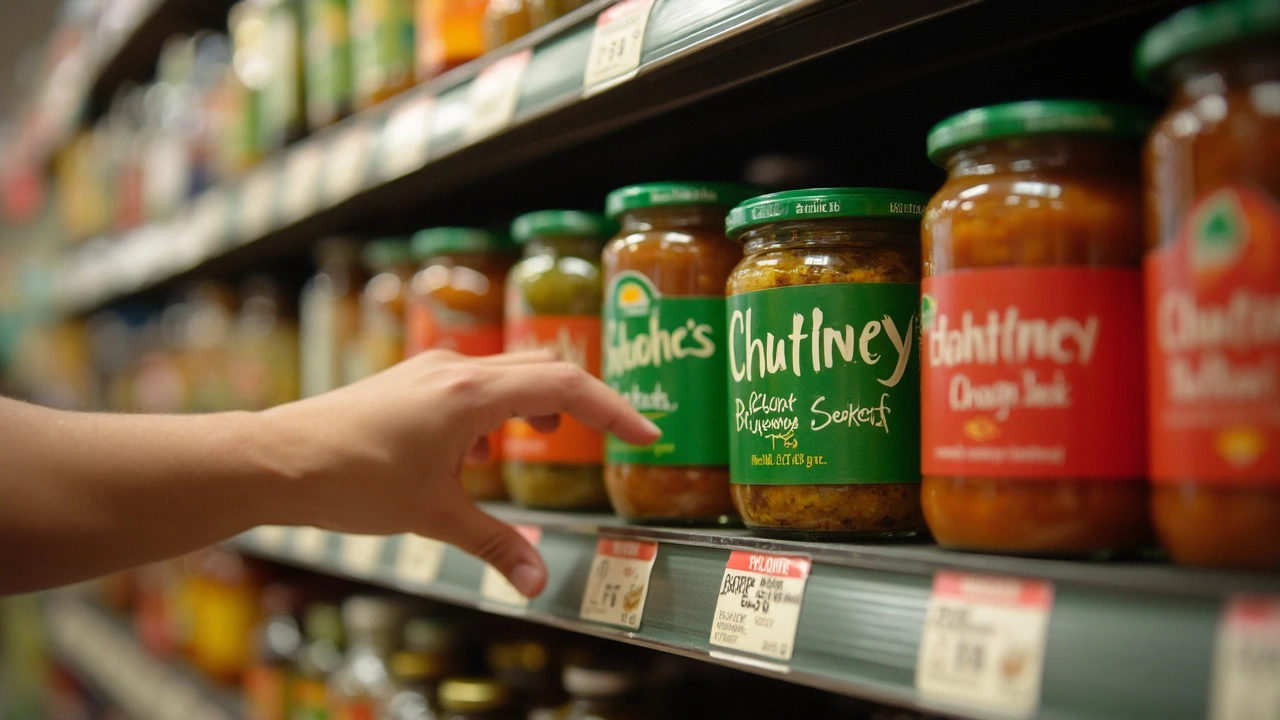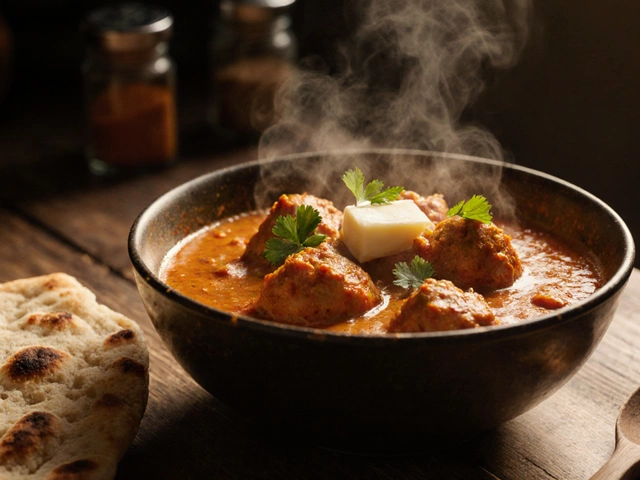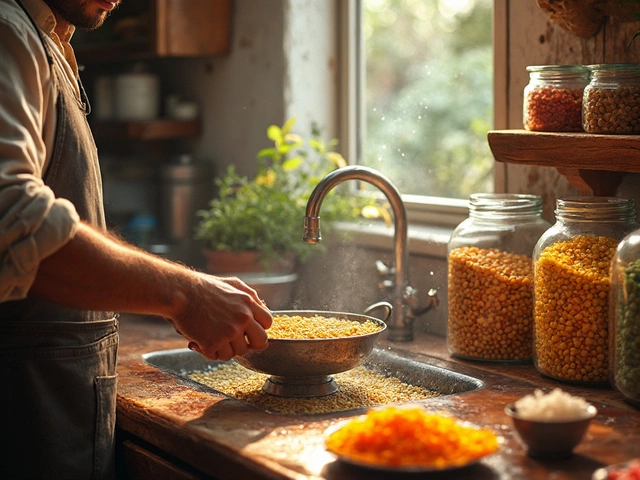Ever find yourself circling the same aisles, smelling bread and passing the peanut butter again while your mental grocery list screams “chutney”? You're not alone. Chutney isn’t like ketchup or mayo; it doesn’t always have a fixed spot in every grocery store.
Most of the time, you’ll want to start in the international foods aisle. This is where stores stick sauces and condiments from around the world—everything from Thai chili paste to Italian pesto. Chutney usually pops up here, especially mango or mint varieties. If your store has specific sections for Indian, South African, or British products, jackpot—you’ll probably see jars of chutney lined up there.
Don’t skip the main condiment section, though. Some chains shelve chutney next to salsa, mustards, and other spreads. The logic? They’re all “serve on the side” flavor boosters. Keep an eye out for smaller jars, since chutney doesn’t always come in family-size chunks like peanut butter.
- Where Chutney Usually Hides
- The International Aisle Mystery
- Refrigerated vs Shelf-Stable Chutney
- Popular Brands and What to Pick
- When to Ask for Help
- Next Steps: If You Can't Find Chutney
Where Chutney Usually Hides
Grocery stores can feel like a maze when you’re looking for something less common—like chutney. It’s not hiding on purpose, but sometimes it seems that way because stores group items really differently. Here’s where to start your search.
- International Foods Aisle: Most chain stores tuck chutney in the aisle with Indian, Asian, or British groceries. Look for jars next to curry sauces, tikka masala, or naan bread mixes. If there’s a little flag on the aisle sign, that’s usually your cue.
- Condiments and Sauces: Some stores keep all their sauces together, so chutney might be chilling near ketchup, BBQ sauce, or salsa. Don’t just look at eye level—sometimes smaller jars are shelved lower.
- Refrigerated Section: Fresh chutney (the stuff sold in plastic tubs) hangs out in the refrigerated deli or specialty cheese area. If you see hummus, olive tapenade, or premade salads, you’re in the right neighborhood.
- Natural/Organic Foods Aisle: In places like Whole Foods, organic or locally made chutneys are usually near the gluten-free or ethnic food shelves.
If you love a quick win, here’s a quick breakdown of popular grocery chains in the US and where they usually hide chutney:
| Grocery Chain | Chutney Location |
|---|---|
| Walmart | International Foods or Asian/Indian section |
| Kroger | Condiments or International aisle |
| Whole Foods | Near cheese/refrigerated or International aisle |
| Trader Joe’s | Seasonal endcaps, sometimes with dips |
| Safeway/Albertsons | International aisle, sometimes shelf-stable condiments |
Stores don’t always agree on a system, so if you don’t spot chutney after a first glance, try the next likely aisle. Chains with bigger international food selections almost always have at least the classic mango type. Smaller grocery chains might skip it, but the bigger stores usually deliver.
The International Aisle Mystery
If you’re hunting for chutney, your first stop should always be the international aisle. Most U.S. grocery stores, especially chains like Kroger, Safeway, and H-E-B, have at least one section labeled “International Foods” or “World Flavors.” This spot is a total mash-up zone—don’t be surprised to find coconut milk next to British tea biscuits. The Indian food section, if there is one, is usually jackpot territory for chutney fans.
Here’s what’s interesting: a survey from 2023 found that 78% of major grocery stores with international aisles stock at least one type of chutney, usually alongside Indian spice mixes, naan, and curry pastes. Mango chutney is the most common, with brands like Patak’s and Major Grey’s leading the way.
The table below shows a quick look at what to expect in some big U.S. chains:
| Store | Chutney Aisle | Common Brands |
|---|---|---|
| Walmart | International (Indian/British section) | Patak’s, Crosse & Blackwell |
| Kroger | World Foods (with Indian products) | Patak’s, Private label |
| Whole Foods | International or sometimes near local, artisanal foods | Local brands, Stonewall Kitchen |
| Publix | International or Specialty Foods | Patak’s, Major Grey’s |
Don’t let the name fool you. Sometimes stores will split the international section by region, so always check the Indian or South Asian shelves first. In stores with a British section, classic British brands are a good bet. Not seeing it? Check lower shelves or end caps—smaller stores sometimes tuck things out of sight.
Pro-tip: Larger Asian and Indian supermarkets will usually have several types of chutney, including niche flavors you won’t find in national chains. That’s your ticket if your recipe needs something beyond basic mango or coriander chutney.
Refrigerated vs Shelf-Stable Chutney
So, here’s where things get a little tricky: not all chutney sits on the same shelf. Some you’ll find at room temperature, and some are chilling in the fridge section. The difference usually comes down to how it’s made and what it’s made of.
Shelf-stable chutneys are the most common in the US. These come in glass or plastic jars, sealed tight and usually packed with vinegar, sugar, and spices—ingredients that naturally keep them fresh. Famous brands like Patak’s or Stonewall Kitchen use these formulas, so you can grab a jar and toss it in your pantry for months. No stress about it spoiling right away.
The refrigerated stuff is less common, but more natural. These are often made in small batches, with fewer preservatives, and can taste a bit fresher. Some smaller grocery stores or health food chains, like Whole Foods, might keep these next to hummus or specialty salsas. If you’re at a specialty store, check the cold section near things like fresh pestos, tzatziki, or pickles.
If you’re not sure which kind you need, here’s a quick comparison:
| Type | Where to Find | Shelf Life (Unopened) | Main Pros |
|---|---|---|---|
| Shelf-Stable | International aisle, condiment shelf | 6-18 months | Easy storage, lots of variety |
| Refrigerated | Cold section, near fresh dips | 2-4 weeks | Fresher taste, fewer preservatives |
The main thing to remember: always refrigerate after opening, no matter which variety you buy. Also, give it a sniff before using if it’s been hanging out in your fridge for a while. Chutney can quietly go bad, and you don’t want any surprises.
And hey, if you ever wonder whether you should go for refrigerated or shelf-stable, think about how fast you’ll use it. If you just need a scoop for a recipe, shelf-stable is your best bet. If you eat it on everything, you might love the flavor punch of the refrigerated type. Either way, chutney shouldn’t be hard to work into your next meal.

Popular Brands and What to Pick
Staring at a wall of jars wondering which chutney to grab? You’ll see a mix of familiar brands and some you’ve never heard of, but a little know-how makes picking the right jar easy.
The big grocery stores often stock these brands:
- PATAK'S: Their Mango Chutney is classic—sweet, tangy, a bit chunky. It’s a go-to for dipping naan, topping grilled chicken, or mixing into yogurt. Patak’s gets high marks for flavor, and it’s available in both major supermarket chains and specialty Indian groceries.
- MAJOR GREY'S: This style bends more toward sweet than spicy. You’ll spot brands like Crosse & Blackwell or Sharwood’s using “Major Grey’s” on the label. It’s often favored by folks new to chutney or those who want a mild taste with a hint of raisins and ginger.
- MRS. BALL'S: Loved by South Africans, Mrs. Ball’s Chutney is a staple in stores with international selections. It’s less chunky, more pourable, and mildly spicy—great with meats or even as a burger topping.
- BOMBAY MAGIC: For something closer to what you’d find on a restaurant table in India, look for Bombay Magic or Swad. These are a bit funkier, have bold spices, and usually come in smaller jars.
- TRADER JOE'S: If you shop here, their Mango Ginger Chutney is a fan favorite for adding zip to cheese platters or turkey sandwiches.
Not sure which kind to get? Here’s a quick breakdown to match your chutney with your plans:
| Brand | Best Use | Flavor Notes |
|---|---|---|
| Patak's | Dipping or cooking with Indian food | Sweet, tangy, little spice |
| Crosse & Blackwell | Cheese boards, glazed meats | Mildly spiced, sweet, a hint of ginger |
| Mrs. Ball's | Burgers, sandwiches, roast chicken | Fruity, smooth, slightly spicy |
| Bombay Magic | Spicing up curries, rice, samosas | Spicier, bold, traditional |
| Trader Joe's | Snacks, dipping, leftovers remix | Sweet, with ginger kick |
Quick tip: Always check the label for spice level—some chutneys have a sneaky kick, even if they look sweet. If you have special diet needs, watch for sugar content and potential allergens like mustard or nuts.
When in doubt, grab a classic mango chutney. It covers almost all the culinary bases and is pretty much guaranteed to work with whatever you’re dishing up.
When to Ask for Help
If you’ve checked the international aisle, the main condiment section, and even peeked in the refrigerated shelves but still don’t see chutney, don’t waste more time wandering. Most big grocery stores have helpful staff (usually wearing name tags) stationed near the entrance or roaming the aisles. A quick ask will often save you way more time than hunting solo.
According to a 2023 survey by Grocery Retail Weekly, 68% of shoppers find hard-to-locate items way faster after asking a store associate. Staff can check their store’s digital inventory and sometimes even lead you right to the shelf if you’re nice about it. If nobody is around, most stores have a customer service desk at the front—these folks know their way around every aisle.
"Our store layouts can change with new product lines or seasonal displays, so don’t hesitate to ask—there’s no shame in it," says Martha Williams, grocery manager at a major US chain.
For best results, try this approach:
- Be specific—say "Do you have any mango or mint chutney?" instead of just "Chutney?"
- Ask where to look, not just if they have it. Something like "Which aisle usually has chutney?" works well.
- If you hear they’re out of stock, ask if they ever carry it or if there are any similar substitutes in stock (like relish, jams, or pickles).
Every store has its quirks. Here’s a snapshot from a recent spot-check of five major US grocery chains and their usual chutney location:
| Store Chain | Chutney Location (Typical) |
|---|---|
| Whole Foods | International foods aisle, top shelf near Indian sauces |
| Kroger | Condiment aisle or global foods section |
| Walmart | Asian/Indian section, lower shelf near curry sauces |
| Publix | International foods or near pickles and relishes |
| Safeway | World cuisines aisle, by packaged Indian meals |
Bottom line? Don’t be shy—if you’re in doubt, asking for help is the fastest way to get your chutney and move on to the more fun part: making your recipe.
Next Steps: If You Can't Find Chutney
Can’t spot chutney anywhere, even after patrolling the aisles and peering into every shelf nook? It happens. But don’t give up yet—there are more ways to get your hands on the good stuff.
First, ask an employee. Seriously, it’s not awkward—grocery staff deal with questions about tricky items all day. They might point you to a weirdly placed display, the deli fridge, or even a secret endcap. Every store has its own logic, and sometimes new stock gets tucked away.
If your local store doesn't carry any brands you're after, check their website or app. Lots of chains offer “in-store pickup” or home delivery, and online inventory sometimes includes specialty items that aren’t on the physical shelf. Just type in “chutney” and see what pops up.
If you still come up empty, try these options:
- Look up Indian or British groceries nearby—these spots almost always have a chutney wall.
- Order from an online marketplace like Amazon, Instacart, or the actual brand’s website. Major brands like Patak’s and Geeta’s ship all over the US.
- Try local delis or specialty cheese shops—some carry mango chutney for cheese boards.
- Make your own. Mango, apple, or tomato chutney comes together fast with basic ingredients from the produce and spice aisles. Tons of easy beginner recipes out there!
With these tricks, you won’t have to give up on that recipe or scramble for a boring substitute. Sometimes the hunt is half the fun—and once you find your favorite chutney source, you’re set for all your samosas, sandwiches, and cheese nights.











